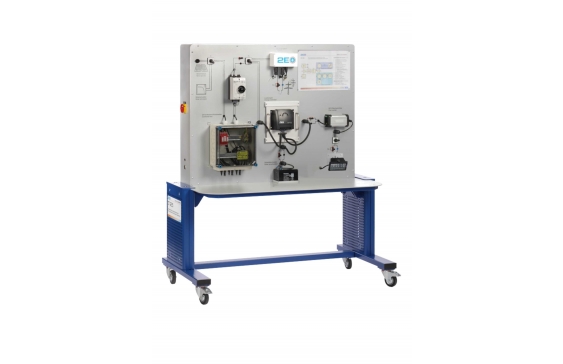ET 255 Using photovoltaics: grid-connected or stand-alone

Photovoltaic solar current can be used to feed into a public power grid (grid-connected operation) or for local consumption (stand-alone operation).
The ET 255 trainer allows typical electrical components to be studied for both possible uses of photovoltaics under different operating conditions.
It can be run both with actual solar modules (such as ET 250) and with the built-in photovoltaic simulator. Operation and parametrisation of the photovoltaic simulator is carried out via a dropdown menu in the software program. With relatively little effort, the photovoltaic simulator makes it possible to investigate the effects of changing illuminance and temperatures.
A variety of software functions are available for capturing and displaying the measurement data. The efficiency and dynamic behaviour of the electrical system components can be studied by analysing these results. These experiments allow for detailed findings on the operation of inverters, charge controllers and MPP trackers.
The ET 255 trainer is fitted with measuring points for current and voltage at the relevant points of the respective connection in order to be able to use external measurement instruments to study the principle of operation of the system components.
- working with electrical components from the real world usage of photovoltaics
- selectable mode for grid-connected or stand-alone operation
- selectable mode for operation with actual photovoltaic modules or with the integrated photovoltaic simulator
Photovoltaic simulator
- max. output: approx. 140W
- short-circuit current: approx. 4,5A
- open-circuit voltage: approx. 40V
Inverter for grid-connected operation
- rated input power: 150W
- max. output power: 125W
- max. efficiency: 89%
Charge controller for stand-alone operation
- charging current: 20A
- end charging voltage: approx. 14V
230V, 50Hz, 1 phase
230V, 60Hz, 1 phase
230V, 60Hz, 3 phases
UL/CSA optional
- trainer with electrical components from practical usage of photovoltaics
- operation with photovoltaic simulator or actual photovoltaic modules
- grid-connected or stand-alone operation
- inverter with MPP tracker for grid-connected operation
- inverter and charge controller for stand-alone operation
- solar battery and lamp for stand-alone operation
- commercially available combiner box
- display of the operation states in the software
- GUNT software for data acquisition via USB under Windows 7, 8.1, 10
- application aspects of electrical components for photovoltaic systems
- efficiency and dynamic behaviour of system components in grid-connected and stand-alone operation
- function of MPP tracker
- function of inverters
- function of charge controllers
- behaviour of components under varying temperature and illuminance

